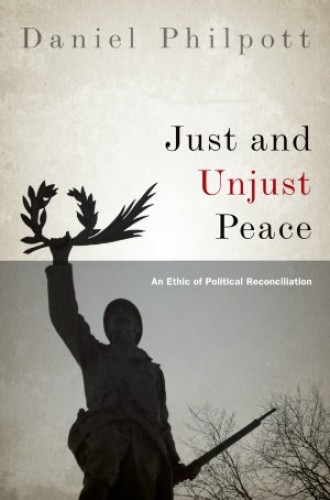Just and Unjust Peace, by Daniel Philpott
Almost a decade after the overthrow of Saddam Hussein, many Americans have become numb to the reports of continued violence in Iraq that are buried in the back pages of newspapers and are barely mentioned on the nightly news. But acts of sectarian violence in Iraq are still frequent and are increasingly large in scale.
On June 13, 2012, car bombings killed 93 Iraqis and wounded 300 others. On July 23, 2012, a series of coordinated attacks on Iraqi security forces and Shi‘ite Muslim communities killed 116 and wounded 299. Three weeks later, on August 12, 128 people were killed and 400 people were wounded in a single day of shootings and bombings in major cities in Iraq. Meanwhile, according to Amnesty International, more captured insurgents were executed by the Iraqi government in the first six months of 2012 than in all of 2011. In July alone, the Court of Cassation upheld the death sentences of 196 Iraqi citizens. The war in Iraq may be over, but one thing is clear: there is no peace.
Read our latest issue or browse back issues.
The challenge of building a lasting peace in the aftermath of war and political violence is an age-old problem that continues to trouble us today. Across the globe—not only in Iraq but also in Bosnia, Rwanda, Kosovo, Ireland, Afghanistan, the West Bank, Somalia, Haiti, the Democratic Republic of the Congo, the Sudan, South Africa and dozens of other settings—people struggle daily to forge a peace that can overcome decades of politically and at times religiously motivated hatred and killing.
Daniel Philpott asks, What is justice in the wake of large-scale injustice? And how can we achieve it? For Philpott, a professor of political science and peace studies at the University of Notre Dame, religion is not only a common source of violence between peoples; it is also our most promising hope of resolving long-standing tensions and reaching reconciliation. “Religious traditions are generators, hosts, and sources of the distinct concepts of justice, mercy, and peace that reside in reconciliation,” he writes. “By retrieving and developing these concepts and adapting them to modern constitutional democracy and international norms, an ethic emerges that offers promise of restoring damaged political orders.”
Philpott acknowledges that the task of convincing key political players to embrace religious concepts of reconciliation and to employ them in resolving political discord is a difficult one. Conservatives, believing that force alone brings about lasting change, reject the use of reconciliation in real-world situations as idealistic and dangerous. Liberals, dedicated to historical notions of the separation of church and state, are often quick to label the use of religious concepts in the political arena as disrespectful to adherents of different religions or no religion. For them, religion is the problem, not the solution—at least in the public sphere.
The potential of reconciliation as a tool of change, though, rests not with theorists but with the actual participants living the conflict. Philpott tells us, “Whatever the traditions and schools involved, the use of rooted reason respects participants by not requiring them to shed their cherished and considered convictions before entering dialogue.” Instead, it allows people’s most deeply held convictions about justice, mercy and truth to enter the situation, with the potential to bear “resonances and resemblances” to notions held by the other actors. The overlapping consensus can be transformative.
Early during Desmond Tutu’s role as chair of South Africa’s Truth and Reconciliation Commission—the body constituted to give voice to those who had suffered unthinkable injustices under decades of apartheid—the archbishop was asked by some of his fellow commissioners to be less religious during the hearings. After all, the commission had been enacted by the new South African constitution and implemented in accordance with parliamentary legislation. Tutu had been opening sessions with a prayer and regularly making overt religious appeals, all the while wearing his full clerical regalia. Tutu agreed to try to forgo the opening prayer, but ultimately he found himself unable to do so. He continued to pray, to lead hymns and to make appeals to Christian concepts of evil, sin, mercy and forgiveness throughout the hearings.
Philpott suggests that this language of religion may have been precisely what made the commission’s work effective in facilitating the establishment of a functional and stable political system in South Africa after years of horrendous oppression. In the face of victims’ testimony regarding acts so appalling that they often left traditional political discourse without a response, Tutu’s Christian words and actions had the effect of “conferring recognition and honor on the victim and respecting the sacred gravity of the moment.” Most of the victims and perpetrators were, like Tutu, Christian. Although the specifics of their beliefs often differed, the “resonances and resemblances” of their deeply held concepts of faith and forgiveness provided a common language for discourse and a path to reconciliation.
The example of Tutu and the Truth and Reconciliation Commission provides a glimpse of what Philpott holds is possible as a response to other instances of large-scale injustice. Precisely because the original acts are so horrific, traditional concepts of retributive and proportional justice fail us. What act of retribution can possibly balance the scales of justice in the aftermath of genocide or apartheid? How can people publicly acknowledge and appropriately redress such acts of evil without responding with equally appalling acts of their own?
For Philpott, the answer requires moving beyond the concepts of justice as retribution and justice as a rebalancing of consequences. We must embrace the notion of justice as reconciliation. As he points out, the Latin root of the word religion is relegate, to “reconnect” or to “bind together.” When applied to modern political contexts, religious concepts of reconciliation “yield a potent medicine for societies who are dealing with troubled pasts and pursuing stable, legitimate political orders.”
Of course, in the instance of South Africa’s Truth and Reconciliation Commission, almost all of the participants—oppressed and oppressors alike—were Christian; thus they shared notions of mercy, forgiveness and reconciliation. Jesus’ sacrifice to restore humanity’s right relationship with God and God’s act of forgiveness through the sacrifice of God’s Son are central narrative threads of the New Testament. Paul uses the Greek equivalent of the word reconciliation 12 times in his letters, even referring in 2 Corinthians to Christ’s “ministry of reconciliation.”
But how can we use the concept of reconciliation to address political contexts, such as that of Iraq, in which not all of the participants are Christian? Philpott dedicates the middle chapters of his volume to a detailed discussion of the centrality of the concept of reconciliation not only to Christianity but to Judaism and Islam as well.
A superficial reading of the Hebrew Bible might lead one to focus on the retributive ethic of “an eye for an eye” and on the God who leveled Sodom for its unjust attacks on the stranger, but the pervasive message of Judaism, according to Philpott, is establishment of right relationship with God. In the Hebrew Bible story of Joseph, son of Jacob, Joseph’s brothers attempt to murder him, then they sell him into slavery. When Joseph later rises to power, he puts his brothers through tests and trials that Philpott describes as restorative. It is through these trials that the brothers come to recognize their evil and to repent. As Philpott explains, “In the end, the justice that Joseph administers is nowhere proportionate to his brothers’ nefariousness nor does God demand measure for measure. Rather, through the course of the plot, relationships are restored.” This restoration of right relationship with God and others is the overarching message of Judaism, and it is at the heart of justice as reconciliation.
Similarly, Philpott views justice in Islam as a matter of establishing a comprehensive set of right relationships, first and foremost with God but also with all others. Surah 49:10 says of Muslims’ relationship to Jews and Christians in a time of conflict: “The Believers are but / A single brotherhood / So make peace and / Reconciliation between your / Two contending brothers / And fear Allah, that ye / May receive mercy.” Surah 4:114 reads, “If / One exhorts to a deed / Of charity and goodness / Or conciliation between people. . . . / To him who does this / Seeking the good pleasure / Of Allah, we shall soon give / A reward of the highest [value].” Because people will inevitably transgress against one another, the ultimate path to right relationships with others is found through forgiveness of transgressors: “If a person / Forgives and makes reconciliation, / His reward is due / From Allah, for Allah / Loveth not those who / Do wrong.”
Philpott’s point here is not to deny that deep historical divisions exist between Jews, Christians and Muslims or even to deny that some of these divisions might have their roots in the foundational texts of the traditions. His point is rather to show that the basis for an ethic of reconciliation can be found in all three religions, thus enabling the application of his concept of justice to political contexts involving not only Christians but Jews and Muslims as well. (Philpott does not attempt to extend his ethic beyond Abrahamic peoples; he suggests—perhaps incorrectly—that reconciliation might not be a strong feature in other religious traditions.)
The value of Philpott’s detailed mapping of concepts of reconciliation in Judaism, Christianity and Islam is not merely to expand the applicability of his ethic but also to add important layers of complexity to his account. Throughout the stories and the teachings of the Abrahamic faiths—from Joseph’s dealings with his brothers and Jesus’ sacrifice on the cross to Muhammad’s triumphant return to Mecca and the mercy he showed his former persecutors—reconciliation is neither easily given nor effortlessly received. Reconciliation is often a long, difficult and painful process that requires certain very specific practices to be performed by all parties.
Philpott outlines the process of reconciliation in the final third of the book, and it becomes very clear that true reconciliation is not cheaply earned. Reconciliation requires the public and sincere acknowledgment of the wrongs done. Through acknowledgment, light is brought to the injustices done to the victims, and the public vocalization of the wrongs ideally inspires contrition in the perpetrators.
Reconciliation also requires reparations. Although many wrongs cannot be righted in an absolute sense, reparations are nonetheless critical to show the depth of remorse for the wrongs done, and they restore some balance between victims and perpetrators. Punishment of the perpetrators “brings down the standing victory of political injustice” and helps to restore the dignity of the victims.
Apologies by those in power help to further dismantle the victory of the past injustice, and apologies from the perpetrators can also help to repair their own souls and facilitate a restoration of right relationships. Finally, forgiveness shows a willingness on the part of the victims to establish a new relationship with the perpetrators. In forgiving, the victims regain their own agency and overcome debilitating anger.
For some survivors of unthinkable acts of violence, reconciliation may not seem like justice at all. In reconciliation, the full consequences of the wrongs committed are not reversed, the punishments inflicted on perpetrators are not proportionate to the crimes they committed, and the victims are asked to give of themselves one more time by forgiving their oppressors. There is a real sense in which the justice of reconciliation is not entirely fair.
All of this may be true, but the power of Just and Unjust Peace is to illustrate that in the aftermath of large-scale political violence, “not entirely fair” may be the best that we can do—and it is much preferable to all other alternatives. Without reconciliation, we may be condemned to continue the age-old cycle of violence and hate.







